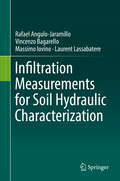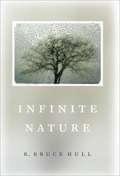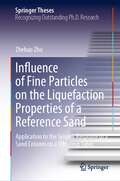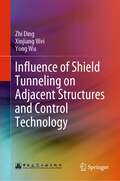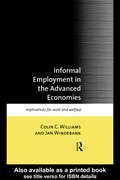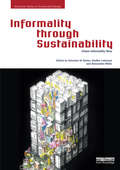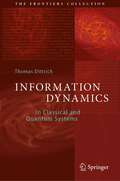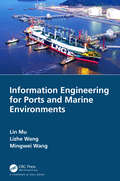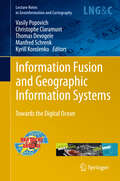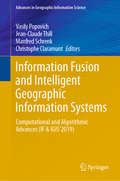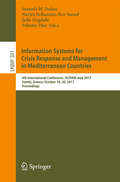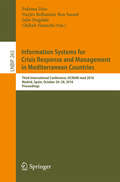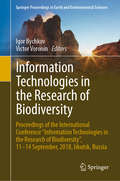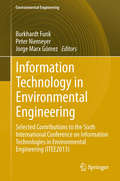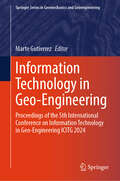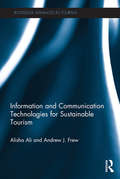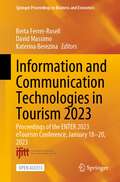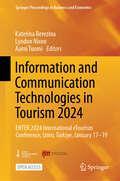- Table View
- List View
Infested: How the Bed Bug Infiltrated Our Bedrooms and Took Over the World
by Brooke BorelBed bugs. Few words strike such fear in the minds of travelers. In cities around the world, lurking beneath the plush blankets of otherwise pristine-looking hotel beds are tiny bloodthirsty beasts just waiting for weary wanderers to surrender to a vulnerable slumber. Though bed bugs today have infested the globe, the common bed bug is not a new pest at all. Indeed, as Brooke Borel reveals in this unusual history, this most-reviled species may date back over 250,000 years, wreaking havoc on our collective psyche while even inspiring art, literature, and music—in addition to vexatious red welts. In Infested, Borel introduces readers to the biological and cultural histories of these amazingly adaptive insects, and the myriad ways in which humans have responded to them. She travels to meet with scientists who are rearing bed bug colonies—even by feeding them with their own blood (ouch!)—and to the stages of musicals performed in honor of the pests. She explores the history of bed bugs and their apparent disappearance in the 1950s after the introduction of DDT, charting how current infestations have flourished in direct response to human chemical use as well as the ease of global travel. She also introduces us to the economics of bed bug infestations, from hotels to homes to office buildings, and the expansive industry that has arisen to combat them. Hiding during the day in the nooks and seams of mattresses, box springs, bed frames, headboards, dresser tables, wallpaper, or any clutter around a bed, bed bugs are thriving and eager for their next victim. By providing fascinating details on bed bug science and behavior as well as a captivating look into the lives of those devoted to researching or eradicating them, Infested is sure to inspire at least a nibble of respect for these tenacious creatures—while also ensuring that you will peek beneath the sheets with prickly apprehension.
Infiltration Measurements for Soil Hydraulic Characterization
by Rafael Angulo-Jaramillo Vincenzo Bagarello Massimo Iovino Laurent LassabatereThis book summarises the main results of many contributions from researchers worldwide who have used the water infiltration process to characterize soil in the field. Determining soil hydrodynamic properties is essential to interpret and simulate the hydrological processes of economic and environmental interest. This book can be used as a guide to soil hydraulic characterization and in addition it gives a complete description of the treated techniques, including an outline of the most significant research results, with the main points that still needing development and improvement.
Infinite Nature
by R. Bruce HullYou would be hard-pressed to find someone who categorically opposes protecting the environment, yet most people would agree that the environmentalist movement has been ineffectual and even misguided. Some argue that its agenda is misplaced, oppressive, and misanthropic—a precursor to intrusive government, regulatory bungles, and economic stagnation. Others point out that its alarmist rhetoric and preservationist solutions are outdated and insufficient to the task of galvanizing support for true reform. In this impassioned and judicious work, R. Bruce Hull argues that environmentalism will never achieve its goals unless it sheds its fundamentalist logic. The movement is too bound up in polarizing ideologies that pit humans against nature, conservation against development, and government regulation against economic growth. Only when we acknowledge the infinite perspectives on how people should relate to nature will we forge solutions that are respectful to both humanity and the environment. Infinite Nature explores some of these myriad perspectives, from the scientific understandings proffered by anthropology, evolution, and ecology, to the promise of environmental responsibility offered by technology and economics, to the designs of nature envisioned in philosophy, law, and religion. Along the way, Hull maintains that the idea of nature is social: in order to reach the common ground where sustainable and thriving communities are possible, we must accept that many natures can and do exist. Incisive, heartfelt, and brimming with practical solutions, Infinite Nature brings a much-needed and refreshing voice to the table of environmental reform.
Infinity in the Palm of Your Hand: Fifty Wonders That Reveal an Extraordinary Universe
by Marcus ChownA mind-bending journey through some of the most weird and wonderful facts about our universe, vividly illuminating the hidden truths that govern our everyday lives. Fact: You could fit the whole human race in the volume of a sugar cube. Fact: The electrical energy in a single mosquito is enough to cause a global mass extinction. Fact: You age more quickly on the top floor than on the ground floor. So much of our world seems to make perfect sense, and scientific breakthroughs have helped us understand ourselves, our planet, and our place in the universe in fascinating detail. But our adventures in space, our deepening understanding of the quantum world, and our leaps in technology have also revealed a universe far stranger than we ever imagined. With brilliant clarity and wit, bestselling author Marcus Chown examines the profound science behind fifty remarkable scientific facts that help explain the vast complexities of our existence.&“The tone is consistently light and breezy...An addictive, intriguing, and entertaining read...A handy guide for anyone yearning to spice up their conversational skills.&”—Booklist&“Heavy stuff lightly spun―just the thing for the science buff in the house.&”―Kirkus Review
Infinity: The Magical Cycles of the Universe (Cycles of the Universe)
by Soledad Romero MariñoThis stunning picture book with a die-cut cover captures how the whole universe flows in eternal natural cycles. The whole universe flows in eternal natural cycles, and this poetic journey captures the beauty of how nothing disappears and everything is infinite! With all things that exist in the universe, when they come to an end, they start over. Nothing disappears completely; everything is transformed over and over again. When winter ends, spring sprouts. After the night, a new day dawns, and from the fruit that has fallen on the ground, a tree grows . . . These are the magical cycles of the universe, and this book shows 11 of them: • Water cycle • Food Chain • Phases of the moon • Cycle of day and night • Seasons of the year • Cycle of migrating birds • Life cycle of butterflies, storks, fish, chickens, and humans Each cycle is represented by a simple definition and an illustration that identifies the main phases, and is followed by an observation to link the concept and a quote from a personality from the world of philosophy, art, literature, or science such as Albert Einstein, Charles Darwin, John Steinbeck, Ray Bradbury, and Jacques Y. Cousteau, and others. The mix of science, poetry, and art is structured in a way that children will be drawn into these 11 natural cycles that are part of everyday life while learning the concept of cyclical time, where nothing disappears and everything is transformed. Whether you are following the migration of birds or discovering the powerful sequence of the food chain, you can trace the progression of science and nature in a way to better understand our existence. • A circular die cut on the cover symbolizes the continuous process of transformation and encourages young readers to open up and discover these magical cycles • Innovative approach to nonfiction information presented in verse with a delicacy and simplicity • Perfect for STEM curriculums Welcome to an incredible journey through infinity!
Influence of Fine Particles on the Liquefaction Properties of a Reference Sand: Application to the Seismic Response of a Sand Column on a Vibrating Table (Springer Theses)
by Zhehao ZhuOver the past thirty years, the liquefaction of sand containing a small amount of fine particles has become an engaging topic in the geotechnical community. Indeed, a great variety of field investigations revealed that the real liquefied soils are mainly composed of a host sand matrix and a small fraction of plastic or non-plastic fines. In this context, several series of monotonic and cyclic triaxial tests were performed to clarify the influence of these fine particles on the development of sand liquefaction. To get closer to in situ conditions, 1g shaking table tests were carried out with two different-sized model soil containers. The first one, small size, was essentially used to check the reconstitution and the saturation method. The second one, very large size, was manufactured to explore the sand liquefaction behaviour during base shaking in an almost actual engineering size. To numerically reproduce the sand liquefaction behaviour, the Dafalias model has been taken as an example and its input parameters were calibrated by an artificial intelligence method. An in-depth analysis of the proposed method was done with the elastoplastic theory.
Influence of Microplastics on Environmental and Human Health: Key Considerations and Future Perspectives
by Yvonne LangMicroplastics have received increased attention in the research world over the last ten years. A number of significant publications by the World Health Organisation, European Union, SAPEA, and GESAMP have highlighted this growing environmental and health emergency. This book provides an accessible introduction to the microplastic problem and details its potential impact both on nature and human health. Filled with the latest developments in the field, it attempts to address the gaps in our knowledge of microplastics and will also propose additional areas of research and impact to be considered to resolve this crisis. It will be of interest to researchers and academics working in the areas of microplastic pollution, microplastic detection, and the impact of microplastics on environmental and human health. It will also be of use to undergraduate students of environmental programmes, analytical programmes, and public health programmes. Key Features: Chapters describe the impact of our reliance on plastics in certain sectors and how they relate to microplastic pollution Investigates emerging solutions to the microplastic pollution Presents a multi-disciplinary perspective, covering topics such as analytical techniques, quantitative techniques, environmental monitoring, and human health monitoring
Influence of Shield Tunneling on Adjacent Structures and Control Technology
by Yong Wu Zhi Ding Xinjiang WeiThis book introduces the synergy theory model to analyze the calculation results of the soil deformation and the lateral displacement law caused by the longitudinal shield tunneling based on in-depth scientific research and engineering practice on deformation of structures caused by shield tunneling. The influence of shield tunneling on different adjacent foundation buildings was studied, and the deformation law and internal force distribution law of the structures were obtained. It aims to help practitioners in understanding the mechanism, predictive analysis method, and corresponding control technology of the influence of surrounding structures’ deformation caused by shield tunneling.
Influence of the Sea Surface Temperature Decadal Variability on Tropical Precipitation: West African and South American Monsoon (Springer Theses)
by Julián VillamayorIn this book the Sea Surface Temperature (SST) patterns of decadal-to-multidecadal variability observed and simulated by 17 general circulation models (GCMs) are analyzed. Furthermore, their impact on precipitation in West Africa and South America and the atmospheric mechanisms involved are assessed. Through this analysis, the effect of external forcings on these impacts and the relative contribution of decadal-to-multidecadal variability patterns of SST to precipitation are presented in depth. Finally, a humid period in the West African region of the Sahel during the 19th century, previously little documented, is analyzed using an atmospheric GCM.The monsoons of West Africa and South America have shown changes in the timescales of a few decades. Previous work suggests a relationship with patterns of decadal-to-multidecadal variability of SST, such as global warming and the Atlantic and Pacific variability. However, the dynamics underlying this relationship and its simulation by current GCMs had not been addressed in a consistent manner. This is the main motivation of this book. The results of this book not only represent a great step forward in our understanding of the changes in the precipitation regimes of the studied regions, but they can also be of great help for the improvement of decadal prediction systems and the associated social consequences.
Informal Employment in Advanced Economies: Implications for Work and Welfare
by Colin C. Williams Jan WindebankRe-Placing Informal Employment challenges many of the popular myths surrounding informal economic activities, and offers a radical reassesment of their extent, growth, location and nature. The book uses case studies from the UK, France, Italy, the Netherlands, the US and Canada to challenge: * the popular belief that informal employment is growing throughout the advanced economies * the myth that this work is undertaken mostly by marginalized groups * the dominant view that we should replace informal with formal employment through enforcement of regulations. Examining policy options and their consequences, the authors show that conventional approaches only increase inequalities and that a radical alternative solution is essential.
Informality through Sustainability: Urban Informality Now (Earthscan Series On Sustainable Design Ser.)
by Steffen Lehmann Alessandro Melis Antonino Di RaimoInformality through Sustainability explores the phenomenon of informality within urban settlements and aims to unravel the subtle links between informal settlements and sustainability. Penetrating its global profile and considering urban informality through an understanding of local implications, the authors collectively reveal specific correlations between sites and their local inhabitants. The book opposes simplistic calls to legalise informal settlements or to view them as ‘problems’ to be solved. It comes at a time when common notions of ‘informality’ are being increasingly challenged. In 25 chapters, the book presents contributions from well-known scholars and practitioners whose theoretical or practical work addresses informality and sustainability at various levels, from city planning and urban design to public space and architectural education. Whilst previous studies on informal settlements have mainly focused on cases in developing countries, approaching the topic through social, cultural and material dimensions, the book explores the concept across a range of contexts, including former Communist countries and those in the so-called Global North. Contributions also explore understandings of informality at various scalar levels – region, precinct, neighbourhood and individual building. Thus, this work helps reposition informality as a relational concept at various scales of urbanisation. This book will be of great benefit to planners, architects, researchers and policymakers interested in the interplay between informality and sustainability.
Information Dynamics: In Classical and Quantum Systems (The Frontiers Collection)
by Thomas DittrichThis wide-ranging book introduces information as a key concept not only in physics, from quantum mechanics to thermodynamics, but also in the neighboring sciences and in the humanities. The central part analyzes dynamical processes as manifestations of information flows between microscopic and macroscopic scales and between systems and their environment. Quantum mechanics is interpreted as a reconstruction of mechanics based on fundamental limitations of information processing on the smallest scales. These become particularly manifest in quantum chaos and in quantum computing. Covering subjects such as causality, prediction, undecidability, chaos, and quantum randomness, the book also provides an information-theoretical view of predictability. More than 180 illustrations visualize the concepts and arguments. The book takes inspiration from the author's graduate-level topical lecture but is also well suited for undergraduate studies and is a valuable resource for researchers and professionals.
Information Engineering for Ports and Marine Environments
by Lizhe Wang Lin Mu Mingwei WangInformation Engineering for Port and Marine Environments provides the technology of tidal level prediction, the technology of oil spill early-warning, and the research for the theory of storm sedimentation, the construction for monitor ability, the early-warning service for numerical simulation and operational, which involves many aspects such as theoretical research, system establishment, and application of information technology, et al. Because of the certain prospective and advancement of multiple work, it will play a positive role in promoting the related technology of the field. There are several of important offshore ports in China, such as Tianjin port, Yangshan Port, Ningbo-Zhoushan port, Huanghua port et al., most of them are located in the coast of muddy and muddy silty, and the depth of water is shallow, the sediment deposition is serious, the large ship is operated by tide. In order to sufficiently keep the rapid and stable economic growth in bay, estuary and delta, guarantee the security of port, channel, maritime, oceanic engineering and resource development of oil and gas, and better escort for the social economy activities, it is essential to provide the information service of sediment and ocean hydrometeorology with width coverage, and forecasting and warning information. It is all the latest research results in the book, which involves many fields such as physical oceanography, meteorology, biology, chemistry, geology, environment, transportation and law and so on. The development of information assurance and prediction system for port shipping and ocean environment is a huge and arduous project. It is too hasty to finish the book, due to the limited knowledge of the author, the careless is unavoidable, cordially invites the readers to point out. Features: An entire system to forecast the port shipping and ocean environment information is proposed, including what is the port shipping and ocean environment information. The concept of port shipping and ocean environment data integration is presented, and the essential modules are built for the ocean dynamics model. The high performance port shipping and ocean environment data processing system is constructed, and the model dataset and geographic information is obtained to build the basic database. The application of information assurance technology for port shipping and ocean environment is conducted at Tianjin port and Yangshan Port. This book is meant for senior undergraduates and postgraduate students in the fields of geoinformatics, Port engineering and Marine engineering. Engineers and technicians in the related fields can also use it for reference.
Information Fusion and Geographic Information Systems
by Christophe Claramunt Manfred Schrenk Kyrill Korolenko Thomas Devogele Vasily V. PopovichThe Workshop Proceedings reflect problems of advanced geo-information science as far as they are specifically concerned with the maritime environment at large. The Proceedings incorporate papers presented by leading scientists researching in the considered professional area and by practitioners engaged in GIS and GIS applications development. They pay close attention to the problems of scientific and technological innovations and the ensuing opportunities to make seas safer and cleaner. Furthermore, they periodically measure the ground covered and new challenges with respect to economic and shipping trends as related to Artificial Intelligence; GIS ontologies; GIS data integration and modelling; Underwater acoustics; GIS data fusion; GIS and corporate information systems; GIS and real-time monitoring systems; GIS algorithms and computational issues; Novel and emerging marine GIS research areas; Monitoring of maritime terrorist threat; Maritime and environmental GIS; Navigation-based and maritime transportation GIS; Human factors in maritime GIS; Coastal and environmental GIS.
Information Fusion and Intelligent Geographic Information Systems: Computational and Algorithmic Advances (IF & IGIS’2019) (Advances in Geographic Information Science)
by Vasily Popovich Christophe Claramunt Manfred Schrenk Jean-Claude ThillThis book gathers the proceedings of the 9th International Symposium “Information Fusion and Intelligent Geographic Information Systems 2019” (IF&IGIS'2019), which was held in St. Petersburg, Russia from May 22 to 24, 2019. The goal of the symposium was to provide a forum for exchange among leading international scholars in the fields of spatial data, information integration and Intelligent Geographic Information Systems (IGIS). The symposium was an opportunity to discuss sound and effective lines of modeling in the fusion of spatial data and information within the broader scope of intelligent GIS. The topics of the 2019 Symposium essentially fall into three broad categories of developments aimed at leveraging the power of spatial information, namely: artificial intelligence; algorithmic and computations processes; and data-informed simulation models. All papers collected here present compelling, cutting-edge research on cloud computing, deep learning, visual analytics, and large-scale optimization. They discuss information fusion and intelligent GIS research in the context of surface and sub-surface maritime activities, port asset management, land-based trip and travel planning, smart city and e-government, emergency management, and environmental monitoring. Given its scope, the book will be of interest to students, researchers and professionals working in GIS, remote sensing, and cloud computing.
Information Systems for Crisis Response and Management in Mediterranean Countries: 4th International Conference, ISCRAM-med 2017, Xanthi, Greece, October 18-20, 2017, Proceedings (Lecture Notes in Business Information Processing #301)
by Ioannis M. Dokas, Narjès Bellamine-Ben Saoud, Julie Dugdale and Paloma DíazThis book constitutes the refereed proceedings of the 4th International Conference on Information Systems for Crisis Response and Management in Mediterranean Countries, ISCRAM-med 2017, held in Xanthi, Greece, in October 2017. ISCRAM-med conferences aim to enhance the collaboration and solidarity between Mediterranean countries in issues related to crisis management. They offer an outstanding opportunity to address and discuss new trends and challenges in the area of Information systems and Technologies for Crisis Response and Management (ISCRAM). The 12 full and 5 short papers presented in this volume were carefully reviewed and selected from 39 submissions. They were organized in topical sections named: social networking and big data analytics; robotic systems for crisis management; decision making in the context of crisis management; serious games and simulations; and collaboration and information sharing.
Information Systems for Crisis Response and Management in Mediterranean Countries: Third International Conference, ISCRAM-med 2016, Madrid, Spain, October 26-28, 2016, Proceedings (Lecture Notes in Business Information Processing #265)
by Paloma Díaz, Narjès Bellamine Ben Saoud, Julie Dugdale and Chihab HanachiThis book constitutes the refereed proceedings of the Third International Conference on Information Systems for Crisis Response and Management in Mediterranean Countries, ISCRAM-med 2016, held in Madrid, Spain, in October 2016. Information systems and technologies can play a key role in crisis management in order to support preparation, response, mitigation and recovery processes. Yet technology is not enough to guarantee a better management process, and therefore the conference does not only focus on engineering technologies, but also on their application and practical experiences. The 12 full and 8 short papers presented in this volume were carefully reviewed and selected from 36 submissions. They are organized in topical sections on mobile apps for citizens, modeling and simulation, development of information systems, information and knowledge management, collaboration and coordination, social computing, and issues in humanitarian crisis.
Information Technologies in the Research of Biodiversity: Proceedings of the International Conference "Information Technologies in the Research of Biodiversity", 11–14 September, 2018, Irkutsk, Russia (Springer Proceedings in Earth and Environmental Sciences)
by Igor Bychkov Victor VoroninThis book offers a collection of papers presented at the First International Conference” Information Technologies in the Research of Biodiversity” that was held from 11-14 September 2018 in Irkutsk (Russia). Papers in this book cover areas of interaction of knowledge on biodiversity and information technologies. The main topics include: methods, models, software systems for the analysis of biodiversity data; global data portals; information and analytical systems on biodiversity; application of remote methods in vegetation mapping; theoretical fundaments and organization technologies of the information and telecommunications infrastructures.
Information Technology in Environmental Engineering
by Jorge Marx Gómez Burkhardt Funk Peter NiemeyerInformation technologies have evolved to an enabling science for natural resource management and conservation, environmental engineering, scientific simulation and integrated assessment studies. Computing plays a significant role in the every day practices of environmental engineers, natural scientists, economists, and social scientists. The complexity of natural phenomena requires interdisciplinary approaches, where computing science offers the infrastructure for environmental data collection and management, scientific simulations, decision support, documentation and reporting. Ecology, environmental engineering and natural resource management comprise an excellent real-world testbed for IT system demonstration, while presenting new challenges for computer science Complexity, uncertainty and scaling issues of natural systems constitute a demanding application domain for modelling, simulation and scientific workflows, data management and reporting, decision support and intelligent systems, distributed computing environments, geographical information systems, heterogeneous systems integration, software engineering, accounting systems, control systems, as well as sustainable manufacturing and reverse logistics. This books offers a collection of papers presented at the 6th International Conference on Environmental Engineering, held in July 2013, in Lüneburg, Germany. Recent success stories in ecoinformatics, promising ideas and new challenges are discussed among computer scientists, environmental engineers, industrial engineers, economists and social scientists, demonstrating new paradigms for problem solving and decision making.
Information Technology in Geo-Engineering: Proceedings of the 3rd International Conference (ICITG), Guimarães, Portugal (Springer Series in Geomechanics and Geoengineering)
by Paulo Cortez António Gomes Correia Joaquim Tinoco Luís LamasThese proceedings address the latest developments in information communication and technologies for geo-engineering. The 3rd International Conference on Information Technology in Geo-Engineering (ICITG 2019), held in Guimarães, Portugal, follows the previous successful installments of this conference series in Durham (2014) and Shanghai (2010). The respective chapters cover the following: Use of information and communications technologies Big data and databases Data mining and data science Imaging technologies Building information modelling applied to geo-structures Artificial intelligence Smart geomaterials and intelligent construction Sensors and monitoring Asset management Case studies on design, construction and maintenance Given its broad range of coverage, the book will benefit students, educators, researchers and professional practitioners alike, encouraging these readers to help take the geo-engineering community into the digital age
Information Technology in Geo-Engineering: Proceedings of the 5th International Conference on Information Technology in Geo-Engineering ICITG 2024 (Springer Series in Geomechanics and Geoengineering)
by Marte GutierrezThis book addresses the latest developments in Information Technologies (IT) for geo-engineering. It contains papers from the 5th International Conference on Information Technology in Geo-engineering (5th ICITG), held in Golden, Colorado, USA, 2024. The book is divided into the following chapters: 1) Geotechnical Instrumentation, Sensor and Sensing Technology; 2) Imaging Technology, Virtual and Augmented Reality, Information and Computer Technology; 3) Data-Driven Investigation and Modeling, Big Data and Databases; and 4) Machine Learning and Artificial Intelligence. IT encompasses a broad field with extensive and powerful uses in geo-engineering, particularly in dealing with large amounts of uncertain data typical of many geo-engineering research and projects. Given its broad range and most up-to-date coverage, the book benefits students, educators, researchers, and professional practitioners, encouraging them to take the geo-engineering community into the digital age.
Information Technology, Systems Research, and Computational Physics (Advances in Intelligent Systems and Computing #945)
by Radko Mesiar Janusz Kacprzyk László T. Kóczy Piotr Kulczycki Rafal WisniewskiThis book highlights a broad range of modern information technology tools, techniques, investigations and open challenges, mainly with applications in systems research and computational physics. Divided into three major sections, it begins by presenting specialized calculation methods in the framework of data analysis and intelligent computing. In turn, the second section focuses on application aspects, mainly for systems research, while the final section investigates how various tasks in the basic disciplines—mathematics and physics—can be tackled with the aid of contemporary IT methods. The book gathers selected presentations from the 3rd Conference on Information Technology, Systems Research and Computational Physics (ITSRCP'18), which took place on 2–5 July 2018 in Krakow, Poland. The intended readership includes interdisciplinary scientists and practitioners pursuing research at the interfaces of information technology, systems research, and computational physics.
Information and Communication Technologies for Sustainable Tourism (Advances in Tourism)
by Alisha Ali Andrew J. FrewSustainable development is a highly topical issue and is of critical importance to tourism as the environment is of utmost importance for the continued development and prosperity of the industry. There have been numerous texts written on sustainable tourism and the measures to mitigate and manage this but none which acknowledges Information and Communication Technologies (ICT) as a mechanism of doing so despite being an emerging area of research. ICT in this context refers to innovative tools which form an integrated system of software and networked equipment that facilitates data processing information sharing communication and the ability to search and select from an existing range of products and services for an organisation’s benefits. Despite the symbiotic relationship, which exists between ICT and sustainable tourism, there has been little research, which has considered how the use of such technology can be used to make sustainable tourism development a more workable reality. This opportune book is the first to provide a focus on the interrelationship of these two important topics demonstrating their synergies and providing insight into a new and innovative approach to managing sustainable tourism development. It considers the use of technology to reduce the negative impacts of tourism from both the demand and supply side perspectives. A critical review of a range of cutting edge technologies used by tourists and businesses to assess their usefulness in managing sustainable tourism development from the macro to the micro level is also discussed. It further integrates examples and practical applications to show how ICT can be an invaluable mechanism in the management of sustainable tourism development. This cutting-edge volume provides a wealth of information on an important yet neglected subject. This book will be invaluable reading for students, researchers, academics and members of the tourism industry looking for new and innovate ways of fostering a more sustainable tourism industry.
Information and Communication Technologies in Tourism 2023: Proceedings of the ENTER 2023 eTourism Conference, January 18-20, 2023 (Springer Proceedings in Business and Economics)
by Berta Ferrer-Rosell David Massimo Katerina BerezinaThis open access book provides an extensive overview of the usage of information and communication technologies in the tourism and hospitality industry. It presents the proceedings of the International Federation for IT and Travel & Tourism (IFITT)’s 30th Annual International eTourism Conference, which assembles the latest research presented at the ENTER2023 conference. The enclosed papers cover various topics within the field, including augmented and virtual reality, website development, social media use, e-learning, big data, analytics and recommendation systems.
Information and Communication Technologies in Tourism 2024: ENTER 2024 International eTourism Conference, Izmir, Türkiye, January 17-19 (Springer Proceedings in Business and Economics)
by Lyndon Nixon Katerina Berezina Aarni TuomiFor more than 30 years, Information and Communication Technology (ICT) has been revolutionizing travel, tourism, and hospitality, and as we look to the next 30 years, the change of pace does not seem to be diminishing. This open-access book provides an extensive overview of the latest developments of ICTs in the tourism and hospitality industry. Featuring papers presented at the International Federation for IT and Travel & Tourism’s (IFITT) 31st annual ENTER International eTourism Conference (ENTER24) held in Izmir, Türkiye, this book presents research on topics such as artificial general intelligence (AGI) in tourism and hospitality; emerging technologies in tourism education; virtual reality; technologies for sustainability, health and wellbeing; big data and analytics, among others. This is an open access book.

